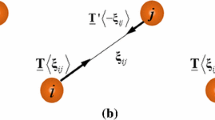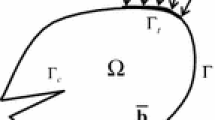Abstract
To further investigate the fracture properties of solid propellant, crack propagation simulation technique is proposed for mode I fracture problems in conjunction with extrinsic cohesive zone model (CZM). Viscoelastic constitutive model for solid propellant and extrinsic Park-Paulino-Roesler (PPR) model constructed to characterize the fracture process are introduced in detail for the computational fracture mechanics approach using finite element method. Topological operations are employed to update the finite element information when extrinsic cohesive elements which represent the new crack facets are inserted. Single edge-notched tension (SENT) and three-point bending test are analyzed to demonstrate the accuracy and effectiveness of the proposed computational framework. Computational results demonstrate that crack propagation simulation technique with extrinsic CZM can provide more accurate fracture response than intrinsic CZM with predefined crack path.














Similar content being viewed by others
References
Gondouin B (1993) Structural analysis of propellant grains. Pergamon, England
Bollard RJH, Dill EH (1967) Structural integrity analysis of large solid propellant motor grains. MSC65-21-2
Cui HR, Tang GJ, Shen ZB (2017) A three-dimensional viscoelastic constitutive model of solid propellant considering viscoelastic Poisson’s ratio and its implementation. Eur J Mech A/Solids 61:235–244
Chu HT, Chou JH (2011) Poisson ratio effect on stress behavior of propellant grains under ignition loading. J Propul Power 27(3):662–667
Liu DD (1997) Crack growth behavior in a solid propellant. Eng Fract Mech 56:127–135
Schapery RA (1975) A theory of crack initiation and growth in viscoelastic media I: theoretical development. Int J Fract 11(1):141–159
Schapery RA (1975) A theory of crack initiation and growth in viscoelastic media II: approximate methods of analysis. Int J Fract 11(3):369–388
Schapery RA (1975) A theory of crack initiation and growth in viscoelastic media III: analysis of continuous growth. Int J Fract 11(4):549–562
Langlios G, Gonard R (1979) New law for crack propagation in solid propellant material. J Spacecraft Rock 16(6):357–360
Long B, Wang HL, Gao SS (2020) Study on the fracture properties of HTPB propellant at low temperature. Propell Explos Pyrotech 45:136–140
Amico FD, Carbone G, Foglia MM et al (2013) Moving cracks in viscoelastic materials: temperature and energy-release-rate measurements. Eng Fract Mech 98:315–325
Özüpek Ş, Iyidiker C (2014) Modeling cracks in nonlinear viscoelastic media subjected to thermal loading. In: Proceedings of the 50th AIAA/ASME/SAE/ASEE joint propulsion conference. Doi: https://doi.org/10.2514/2516.2014-3803.
Zhao JL, Gao B, Zhao JF (2014) Numerical analysis of mesostructure damage for composite solid propellant using a combined XFEM-cohesive zone model. Appl Mech Mater 551:71–76
Wang WQ, Zheng J, Chen X et al (2015) Numerical simulation of crack propagation in CMDB propellant based on extended finite element method. J Propul Technol 36:149–154
Han B, Ju YT, Zhou CS (2012) Simulation of crack propagation in HTPB propellant using cohesive zone model. Eng Fail Anal 26:304–317
Zheng J, Yu JQ, Zhou CS et al (2016) Research on fracture property of CMDB propellant based on cohesive zone model. J Propul Technol 37:2182–2186
Barenblatt GI (1959) The formation of equilibrium cracks during brittle fracture. General ideas and hypotheses. Axially-symmetric cracks. J Appl Math Mech 23(3):622–636
Barenblatt GI (1962) The mathematical theory of equilibrium cracks in brittle fracture. Adv Appl Mech 7:55–129
Dugdale DS (1960) Yielding of steel sheets containing slits. J Mech Phys Solids 8(2):100–104
Cui HR, Shen ZB, Li HY (2019) Cohesive zone model for mode-I fracture with viscoelastic sensitivity. Eng Fract Mech 221:106578
Wang JL (2007) Cohesive zone model of FRP-concrete interface debonding under mixed-mode loading. Int J Solids Struct 44(20):6551–6568
Li W, Yang XH, Zhang GB et al (2017) Cohesive zone modeling of creep-fatigue crack propagation with dwell time. Adv Mech Eng 9(10):1–7
Ravi-Chandar K, Yang B (1997) On the role of microcracks in the dynamic fracture of brittle materials. J Mech Phys Solids 45:535–563
Needleman A (1990) An analysis of decohesion along an imperfect interface. Int J Fract 42(1):21–40
Petersson PE (1981) Crack growth and development of fracture zones in plain concrete and similar materials
Niu RM, Zhou QC, Chen X et al (2014) Experimental and numerical analysis of mode II fracture between propellant and insulation. Int J Adhes Adhes 52:1–10
Cui HR, Shen ZB, Li HY (2018) A novel time dependent cohesive zone model for the debonding interface between solid propellant and insulation. Meccanica 53:3527–3544
Zhang ZY, Paulino GH, Celes W (2007) Extrinsic cohesive modelling of dynamic fracture and microbranching instability in brittle materials. Int J Numer Methods Eng 72:893–923
Choi HB, Park K (2019) Removing mesh bias in mixed-mode cohesive fracture simulation with stress recovery and domain integral. Int J Numer Methods Eng 120(9):1047–1070
Baek H, Kweon C, Park K (2020) Multiscale dynamic fracture analysis of composite materials using adaptive microstructure modeling. Int J Numer Methods Eng 121(24):5719–5741
Yang JF, Lian HJ, Nguyen VP (2021) Study of mixed mode I/II cohesive zone models of different rank coals. Eng Fract Mech 246:107611
Sping DW, Leon SE, Paulino GH (2014) Unstructured polygonal meshes with adaptive refinement for the numerical simulation of dynamic cohesive fracture. Int J Fract 189:33–57
Baek H, Park K (2018) Cohesive frictional-contact model for dynamic fracture simulations under compression. Int J Solids Struct 144–145:86–99
Park K, Paulino GH, Roesler JR (2009) A unified potential-based cohesive model of mixed-mode fracture. J Mech Phys Solids 57:891–908
Cui HR, Tang GJ, Shen ZB (2016) Study on viscoelastic Poisson’s ratio of solid propellants using digital image correlation method. Propell Explos Pyrotech 41(5):835–843
Acknowledgements
This work is supported by the Natural Science Foundation of Jiangsu Province (BK20210435).
Author information
Authors and Affiliations
Corresponding author
Ethics declarations
Conflict of interest
The author declares that he has no conflict of interest.
Additional information
Publisher's Note
Springer Nature remains neutral with regard to jurisdictional claims in published maps and institutional affiliations.
Rights and permissions
About this article
Cite this article
Cui, H. Numerical simulation of crack propagation in solid propellant with extrinsic cohesive zone model. Meccanica 57, 1617–1630 (2022). https://doi.org/10.1007/s11012-022-01516-6
Received:
Accepted:
Published:
Issue Date:
DOI: https://doi.org/10.1007/s11012-022-01516-6




